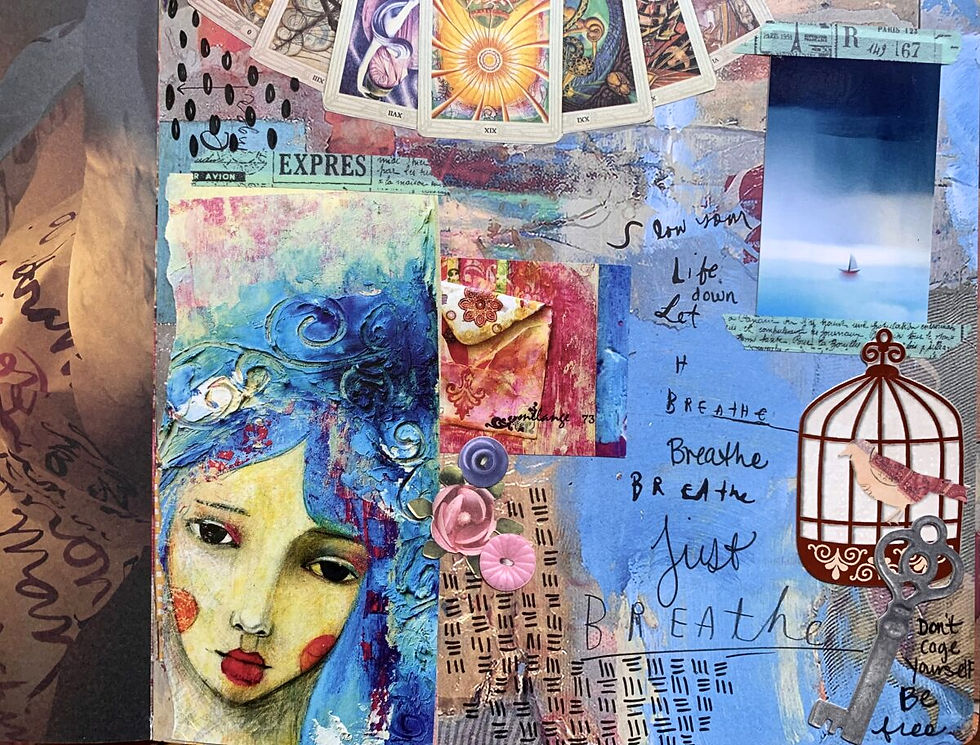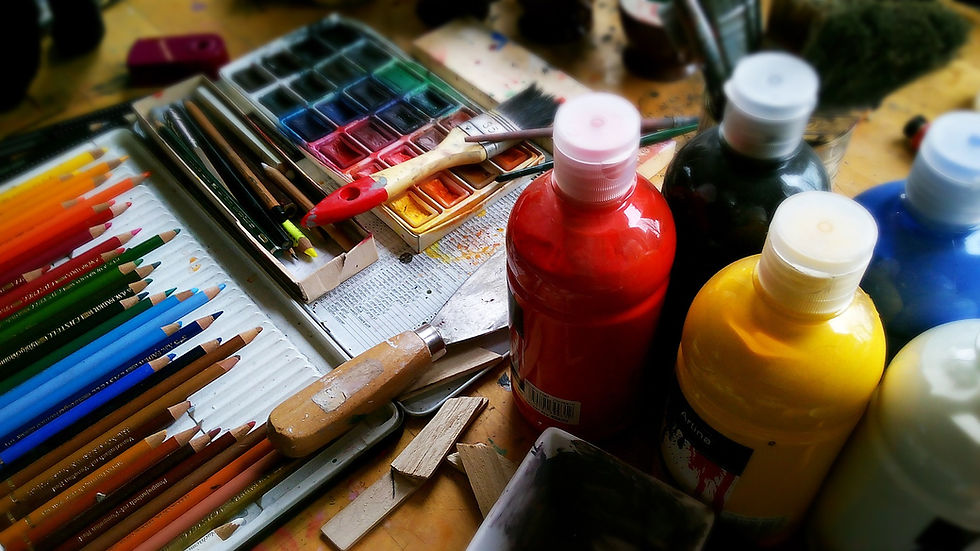"Art is the only way to run away without leaving home." — Twyla Tharp

Our imagination gives us wings to soar high and we take the flights of fantasy where there is no fear, no worries, and nothing to brood over. Artistic expressions are such rare passwords to the surreal world of Neverland, the mysterious land where we can roam about uninhibited, without any pretention. We all love to escape in dreams, right! Art can also be our partner in this journey to Utopia! Art has long been considered a medium for self-expression, offering individuals a way to communicate their deepest and most sublime feelings that they cannot process or speak out loud. Apart from being visually appealing, art serves as a powerful therapeutic tool, helping souls in healing, self-exploration, and growth. So, art can be a powerful tool for those who're struggling to get their messages through.
While an individual engages in artistic creation it becomes easy for themselves to process complex emotions, bust stress, and have a better understanding of their inner worlds. These are the factors that are taken care of by art therapy activities, expressive arts therapy, and visual arts in boosting mental health and emotional well-being. If you’re curious about how art can support an individual’s healing journey, do explore this blog.

Art and the Sense of Freedom
1. Engage All the Senses
Art therapy is a deeply sensory experience that involves seeing, touching, smelling, etc. The physical intimacy of working with materials like color, paints, clay, or collage elements adds a layer of sensory connection to the creative process. This involvement has a deep healing effect, enhancing emotional expression and offering a sense of connection. Engaging the senses through art not only soothes a soul but also helps to blend emotional and physical experiences. Art therapy sessions are dedicated to study these sensory experiences and how they help people feel more connected to their emotions and environments.

2. Wear Your Emotions: Set them Free
The artistic activities like painting, creating crafts, making collages and clay models help us to express our innermost feelings that we start to enjoy thoroughly. It works as a catharsis when an artist literally delves into the world of colors, shapes, and forms, translating their emotions into experiences. This emotional release is especially beneficial in art therapy for depression, trauma, or anxiety, giving an outlet for feelings that overwhelm us or we keep them as suppressed emotions for long. Healing art therapy allows individuals to process these emotions in a better way.
3. Awareness of Self: Explore Your Inner World
"Every artist dips his brush in his own soul, and paints his own nature into his pictures." — Henry Ward Beecher
The creative process that is related to art activities work as a mirror, sneaking into some hidden corners of an individual’s psychological world. Creating artworks involves great understanding of self, making people aware of their emotional aspirations, unlocking the unconscious self. This exploration of self-awareness really helps to connect with the world outside. Over time, this self-exploration boosts confidence and leads to personal growth. Thus, art therapy counselling does wonders for people who lack confidence or have lost their purpose in life, promoting them to a realm of emotional resilience.

4. Deactivate the Stress Button
"Art should comfort the disturbed and disturb the comfortable." — Cesar A. Cruz
The creative process of art-making has been proven to bust stress levels and help people to unwind. It allows the mind to focus on the more positive activities rather than harping on the gloomy sides of the matter, to stay away from all sorts of worries and anxieties, delving in the state of pure bliss. This soothes stress, giving a sense of mental clarity, and emotional well-being. Art based therapy likewise opens a door to happiness and creative freedom and we get ready to face creative challenges stepping out of our cocoons.
Art as a Magic Wand for Self-Expression
"Creativity takes courage." — Henri Matisse
For artists, creating is somehow related to self-expression as they work as a signature of the distinctive style and form of the creator. While art transcends all barriers of communications, breaking language and spatial barriers, expressive arts therapy makes this process more enriched and fulfilling. It helps an artist to blend subconscious material and bring it into conscious awareness. This process often expands visions for an art-seeker, enriching not only their work but also their emotional and psychological health.

In this therapeutic setting, individuals enjoy the gush of emotions flowing on the canvases, helping them deal with the unresolved conflicts, or unattended desires. This exploration helps them find themselves rooted to reality and feel grounded. Art therapy and trauma sessions, thus, often look for visual arts to deal with difficult mental states and regain the much-needed sanity and poise.
Practical Art Therapy Activities: How They Trigger the Happy Feeling
"Art speaks where words are unable to explain." — Mathiole

Art therapy works magic for every single soul, regardless of artistic skill or experience. These are some of the popular artistic activities that help in emotional expression and healing:
Drawing and Painting Emotions: Drawing or painting uses colors, lines, and shapes to represent feelings. Colors help us to relate our fear, anger, happiness, hope and gamut of expressions. Working with soft pastels can evoke calmness. This way, we can give our emotions a visual form and process our experiences.
Creating with Clay: Playing with mud can have a profound effect on our emotions. As children, many of us spent hours building mud pies and creating imaginary worlds out of dirt and water. But playing with mud isn't just for kids – it can be a therapeutic and cathartic experience for adults as well. So, artists and individuals engaged in clay modelling will know the extremely happy feeling associated with it!
There's something deeply satisfying about squishing mud between fingers, molding it into shapes, and feeling the cool, wet texture. It can be stress-relieving in a way that allows us to let go of our worries and focus on the present moment. Clay modelling allows us to express ourselves in a unique way, to create a world of our own. Whether we build a mud sculpture or simply make mud pies, the act of creating frees us from all sorts of worries.

Mask Making and Collage Activities: Designing and painting masks, or making collages can enhance the power of concentration for individuals; they can be aware of the various roles they play in their lives. These activities often reveal parts of the self that may be suppressed or ignored for some reason. So, these crafts can make people aware of their personalities.
Art Journaling: This is also a very relaxing and creative expression to combine visual art with written reflections. Art journaling encourages individuals to study their thoughts and feelings visually and in written form, creating a blueprint of their thoughts and ideas.

"Painting is just another way of keeping a diary." — Pablo Picasso
Why Art Therapy Matters at All
"The object of art is not to reproduce reality, but to create a reality of the same intensity."
— Alberto Giacometti
Art does not stop creating something visually appealing; it starts from there, as an endless process of healing and exploration at the same time. You can paint, build sculptures, make collages, or any kind of art-making for that matter - the act of creation will help you connect with your emotions and release the negative impulses. Children and adults who suffer from some neurological disorders or have some speech impairments can enjoy art and activities without having to utter a single word. You can speak volumes through art!

"Art enables us to find ourselves and lose ourselves at the same time."
—Thomas Merton
While someone is deeply engaged in the act of creation, not only they let others see their works, but they see themselves from an onlooker’s perspective, without any judgement or bias. This helps in restoring mental strength and confidence as individuals. Art therapy and mental health practices thus work together to give meaning to our existence and celebrate life to the brim.
As an artist, an art-seeker or an individual, let art therapy help you to confront your own inner demons, dispel all negative energies and tap into the creative resources which we all possess. If needed, you can take help of a professional art therapist, or you can walk on this path of salvation on your own, guided by your own instincts and some art materials to help in the process.

Let art heal, inspire, connect you to the world of happy canvases!
"Art washes away from the soul the dust of everyday life." — Pablo Picasso
コメント